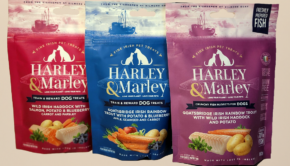Net profits

Health is wealth during recessionary times, so it’s no surprise seafood is still making a splash; being one of the most naturally healthy foods available.
10 June 2009
At a glance: FISH AND SEAFOOD
- John West is the brand leader in the canned seafood market with a 74.7% value market share in the Republic of Ireland (Source, Nielsen scantrack market audit ROI April 2009)
- There has been a shift towards canned products in the last 12 months, during which John West has gained market share
- Rob Roy’s range of prawns and tinned fish enables consumers to easily incorporate Omega 3 fatty acids into their diet
- Donegal Catch remains the number one frozen fish brand on the market with a market share of 58% and a value worth of over €36 million (AC Nielsen May 09)
- Membership numbers for BIM’s Seafood Circle in 2009 have grown to 155
- BIM’s Seafood Circle has three categories; supermarket seafood counter with 27 members, seafood specialist with 37 members and hospitality with 91
The Irish seafood industry performed robustly in 2008 despite very difficult trading conditions in all principal markets, reports Bord Iascaigh Mhara (BIM). Total retail sales volumes of seafood increased by 12% in 2008 while value sales increased by 3.2% to €185.8 million.
Salmon emerged as the seafood sector’s star performer, according to BIM. Salmon sales increased by 13% in 2008 to €58.7 million and pre-packed sales of salmon were up a substantial 28.8% on 2007. The pelagic sector, that is fish from water not close to the bottom of the sea, also performed well where sales of mackerel, horse mackerel, blue whiting and herring reached €130 million.
Sustainability is crucial
Sustainability in sourcing fish is essential, according to Brendan Murphy, MD of John West Ireland (trading as Irish Seafood Investment Ltd). Murphy says John West sources all of its salmon in Alaska, which has reached the “gold standard” as far as sustainability practices are concerned, “higher even than any standard set by the MSC [Marine Stewardship Council].
“In all other markets, we only buy from properly regulated vessels that work to set quotas, there’s no drift-netting [and] no by-catch,” he says.
Murphy believes consumers started to become very concerned about the sustainability issue last year. This is why John West Ireland developed an ‘eco-zone’ project with www.pigsback.com to “showcase the work John West is doing to ensure the product is caught in a sustainable manner.”
Pink or red?
Despite Alaskan “escapement levels” whereby a high number of salmon must be allowed back to respawn, pink salmon there had a poor year in 2008. Murphy explains: “On average in Alaska, there would be 80 million salmon per annum, that was down to 55 million last year. These figures account for 40% of the population, as 60% is allowed through to respawn.”
Pink salmon had a poor cycle in 2006 and 2008, and because the cycle repeats itself, Murphy says, “we can expect in 2010 the catch will probably be lower.”
On the other hand, red salmon had previously performed better, so a good year is expected for 2009. John West will therefore try to secure enough product to meet market demand for this year and next year. But says Murphy, this of course is subject to fishing quotas and when the fisheries board says stop, “everybody downs their tools and stops fishing…They want an industry to be there in 200 years.”
Murphy says John West subsequently won’t have the quantities to promote pink salmon, “so we’ll basically concentrate on base-rate sales of pink.”
Commercial activity will focus on red salmon instead. However as Murphy notes: “That was fine during the last couple of years because the market was slowly drifting towards red. Red has a four year cycle and the product is more expensive; it’s a much richer product as well with higher omega 3 content, but because of its price tag, the market seems to be swaying back to pink again.”
In the Irish market
When asked about the company’s Irish credentials, Murphy responds that it’s making “no false claims, we’re not of Irish origin.” But the Irish division does make a positive contribution to the economy nonetheless, in that it employs 12 people directly and, indirectly through its service provider, “a lot more.”
Murphy admits that with Tesco looking at sourcing from the UK and direct from source, “it is a challenge on us as an organisation to add value at a local level; to be competitive and cost-conscious.”
To what extent does Tesco’s switch affect John West in Ireland though? The biggest difficulty, explains Murphy, is “a plannogram which reflects John West having a 32% market share in the UK, but in Ireland it has a 74% market share.
“Also even though the two markets are quite similar, there are some basic fundamental differences in ranging and pack sizes. I think portion control is a far bigger consideration in the Irish market than in the UK market where there’s a much stronger bias towards larger pack sizes and multi-packs, whereas Ireland favours smaller sizes.”
John West sources circa 8% of its product in Ireland, from Donegal. On the subject of BIM, Murphy comments: “They have a mandate to promote Irish fishing as opposed to promoting consumption of fish…but from a marketing perspective, BIM should be promoting the consumption of fish, and that’s more of a health and wellness agenda…We’ve tried to engage in joint operations with BIM but basically their mandate is very much [that] they can’t be seen to be supporting brands.”
John West has set up a new website www.brainfood.ie, which provides key nutritional information about fish.
Go west
John West is the brand leader in the canned seafood market with a 74.7% value market share in the Republic of Ireland (Source, Nielsen scantrack market audit ROI April 2009). Supplying quality fish products for over 140 years, its range includes tuna, salmon, mackerel and sardines, sourced from over 30 countries including Ireland.
As product quality has always been the cornerstone of John West’s business, and of its reputation among consumers, so too is sustainability now a core focus, in order to retain that quality in the future. The group says it takes its responsibility to ensure continuity of fish stocks for future generations very seriously. In addition to a rigorous selection process in choosing suppliers, John West is committed to the United Nations Convention on the Law of the Sea (UNCLOS) and fully supports the regional fisheries management regimes espoused by it.
Across all the products in the range, the company continues to work with suppliers, governments, the EU and NGOs to maintain and improve on all environmental aspects of the food supply chain.
John West’s business in Ireland is considered to be the strongest and best performing in the MWBrands operation and it is committed to a long-term future in the Irish market. They continue to invest in the Irish marketplace and in the various stakeholders in the chain.
An ocean of goodness
Nutritionists now recommend that consumers eat seafood containing Omega 3 poly-unsaturated fatty acids at least twice weekly. Omega 3 has been proven to contribute towards a healthy heart and body by protecting against coronary heart disease.
The Rob Roy range of prawns and tinned fish fits perfectly with today’s increased demand for healthier and more natural foods and is a great way to easily incorporate Omega 3 fatty acids into any diet. Rob Roy prawns are also an excellent source of protein and also contain iron, zinc and vitamin E. They are quick and easy to cook, whether steamed, boiled, fried, grilled, baked or barbecued.
The Rob Roy range of tinned fish includes Rob Roy Sardines, available in oil or tomato sauce, and Rob Roy Brisling, available in oil or tomato sauce. Both are ideal for serving on crackers and bread, in a pasta dish, or used as a pizza topping.
A real catch
Donegal Catch remains the number one frozen fish brand on the market with a market share of 58% and a value worth of over €36 million (AC Nielsen May 09). The brand continues to create excitement in the frozen fish category and is no strangers to innovation; launching two new products ideal for the convenience sector. The first of the two is the Donegal Catch Lemon & Herb Chunky Cod two-pack, two premium natural chunky filets with a tasty lemon and herb crumb. The second is a 400g foil bag of Donegal Catch Yellowfin Sole with a unique Italian style bread crumb. Donegal Catch believes both new products offer fantastic value for money and will prove popular with consumers.
The brand also claims that with Donegal Catch “you only get the best fish.” The company only uses 100% natural fillets in all its products, with no bones and no skin, just filleted and frozen. Other frozen fish is often either formed or minced, and often with the skin still on. However with Donegal Catch, consumers are always guaranteed “fish the way it should be.”
Seafood Circle going swimmingly well
BIM/Irish Sea Fisheries Board, the state agency with responsibility for the Irish fishing and aquaculture industry, developed the Seafood Circle initiative to support and encourage restaurateurs and retailers that consistently deliver the highest standards of seafood and service to their customers. The purpose of the programme is to assist the retail and foodservice sectors to achieve excellent standards in the provision of seafood for retail and foodservice sale, and encourage the use of locally sourced, responsibly fished, quality seafood. The programme also aims to enhance consumer confidence by communicating to consumers that they can expect quality seafood and service in BIM Seafood Circle member outlets.
Seafood Circle membership numbers jumped to 155 in 2009; 27 supermarket seafood counter members, 37 seafood specialist members, and 91 members within hospitality. All multiple, symbol groups and independent supermarkets offering a range of seafood from a wet fish counter, as part of a much greater offering of other foodstuffs, are invited to apply for membership in the supermarket seafood counter category.
Currently, 18 Superquinn stores have achieved on-going membership along with Donnybrook Fair, Donnybrook, Twomey’s Supervalu, Deansgrange, Co Dublin, Condron’s Supervalu in Clane, and Scally’s Supervalu in Clonakilty. Newcomers in this category are Riordan’s Supervalu, Fermoy and Pettitt’s Supervalu, Wexford. They are joined by the two new Superquinn stores in Ranelagh and Portlaoise.
The seafood specialist category is open to seafood retailers who derive in excess of 50% of their turnover from seafood sales and where the retail portion of their premises does not exceed 250 sq m.
The retail element of the programme is assessed by experienced BIM personnel and independent assessors. Applicants received at least two visits during the assessment period and report their findings to an independent approvals committee. Membership is awarded on an annual basis and may be withdrawn at any stage if an establishment fails to continue to meet the criteria necessary.
A key element of the programme is to help retailers identify gaps in product quality and customer service and assist them to bridge those gaps. Typical examples include the development of a labelling system for independent retailers to ensure that all product displayed meets with legislative requirements, and staff development workshops on product knowledge, preparation and customer service. The workshops are held in BIM Seafood Development Centre which is equipped with a specially designed filleting room and kitchen area. Participants gain hands-on experience in several aspects of fishmongering and also build their culinary skills and product knowledge repertoire by spending time preparing and cooking seafood.
BIM offers a wide range of supports exclusively for Seafood Circle members including promotional and PR activity, point-of-sale material, regular newsletters, workshops, mentoring, and a designated website www.seafoodcircle.ie.
The message for consumers is to buy and enjoy seafood where they see the distinctive plaque denoting membership. For more information contact John Hackett at Hackett@bim.ie.



 Print
Print





Fans 0
Followers